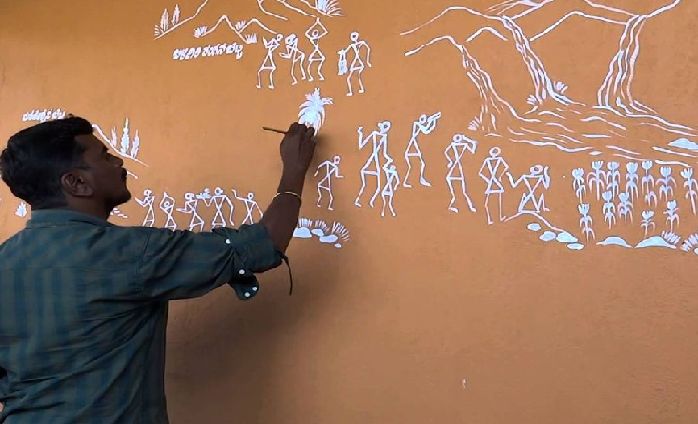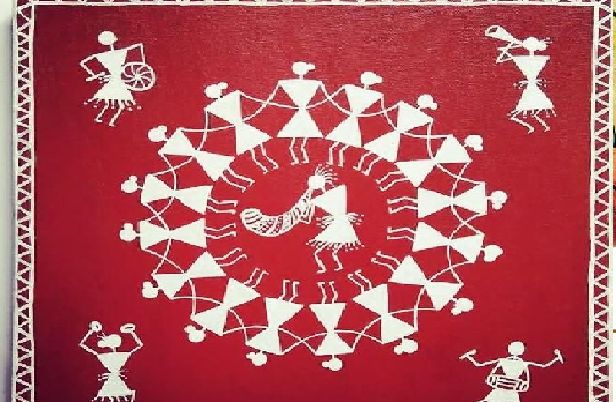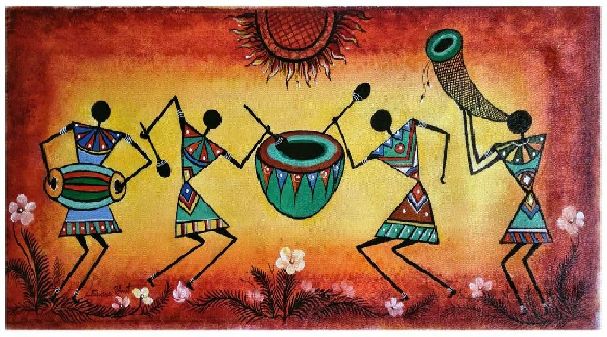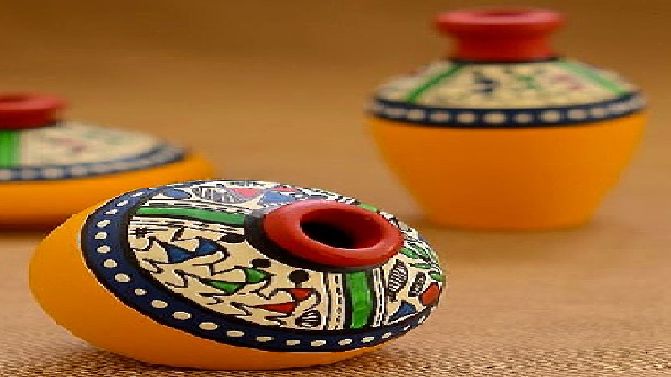Warli Paintings Easy
Sep 16, 2019 • 952 views
History of Warli
Warlis are an indigenous tribal community living on the coastal region of Maharashtra-Gujarat border and the surrounding areas. It is these communities that the Warli art actually belongs to. One of the oldest tribal arts of India these paintings, despite the lack of concrete evidence seems to have come into existence around 2500 - 3000 BCE. These paintings are quite similar to rock paintings done inside many caves, Rock shelters of Bhimbetka, in Madhya Pradesh to be specific. Being an expression of art, these paintings act as evidence of social and cultural atmosphere of that time. We understand the history of the tribal community of that region through these paintings.

Warli Painting Inspired by Daily Activities- Source: Passion Connect
Warli, the Easy Way
Amidst the plethora of art forms and paintings from the past which are known for their intricacy, minute details, elaborate designs and finesse, Warli paintings show quite contrasting features. They are one of the simplest tribal art forms of India. Whether it is the materials that are used, the way the paintings are made or the sources of inspiration, all of them give an indication towards the ease and simplicity that these paintings posit.
The process of producing any art begins by being aware of the materials that are to be used and how they are to be used. In case of Warli paintings, the fact that they were originally done by the tribal people, the materials used in this art form would be something which are easily available and are a part of the immediate surroundings. Originally these paintings were done on the ochre walls of the huts which are made using materials like mud, bamboo branches, cow dung etc.
In the contemporary times which bear the marks of urbanization, it is difficult to find huts or walls that are made of mud, water and cow dung, so one can always use hardboard, canvas or any such material to act as the base. However, these bases can be made to look more like the original ones by turning them into the same red, muddy colour that is seen on the walls of the huts.
Next step is to make the paint for our designs. These paints can be prepared either in the authentic way by combining rice and water to form a sticky paste or simply the paints that our used in any other everyday painting can be taken. Since originally due to lack of paints, the paste which is white in colour was used so even if we are using paints it is better to apply white paint only to give a more authentic appeal.
In the past chewed bamboo sticks were used as a brush but in our everyday practice we can simply replace those sticks with painting brushes. The next and the final step is to draw the design on our chosen background. After the designs are made, the painting is left to dry following which it is completely prepared.

Warli Art in Making - Source : Craftsvilla
Basic Themes, Styles and Variations
The theme around which Warli art usually revolves is Mother nature. Natural elements like flora, fauna and even humans are the ones which are depicted in Warli paintings. The people of Warli community are strongly connected with nature, unlike the people from other parts whose life begins and ends surrounded by brick houses and tall buildings. It is this connection and respect towards wildlife that warli paintings highlight in them. The characteristic elements seen in these paintings include geometric patterns of flowers, animals, rituals practised by the people, hunting scenes, dances and other everyday activities. A fascinating feature of warli art is that instead of straight lines, dots, circles, crooked lines, rectangles, triangles and other shapes are used. Another important element that can be observed in these paintings is a certain kind of dance form where men and women join their hands and move around in circles while the music plays. The musical instrument used is ‘Tarpa’ hence, this dance is called Tarpa dance. These paintings are all about rustic charm and the stories that they tell.

Warli Painting Showing Tarpa Dance - Source: Events High
Traditional and Social Connections
The people of Warli tribe are originally nature worshippers and this connection of theirs is seen through their art. Their use of simple nature inspired elements is an evidence of their unpretentious lifestyle and their belief of the elements of the universe being in equilibrium Warli paintings were an essential part of auspicious occasions such as weddings, festivals etc and were and are still used to decorate the houses of the tribal people as a symbol of joy and good times. It was usually done by the women especially during marriages, where all married women would come together to express their joy.
Warli in Modern Times

Warli Art Wall piece - Source: Tribal Craft
Like any other art form which has survived the test of time, warli art too has gone through an evolution. From the walls of the huts belonging to warli community people to an artistic expression which can be seen almost anywhere and everywhere, warli has come a long way. The feature of warli art to fit into any form is what has made it so popular. Maybe not in the authentic sense, but warli art is seen on various products such as lamps, wallpapers of cafes and hotels, book covers, clothing and the list goes on. Considering its versatile nature, warli paintings are one of those which will keep on spreading their magic in the future as well.

Warli Art on Miniature Pot - Source: Unravel India
Preserving the Art Form
The popularity of warli art in the present scenario is not something that was naturally possible, but it is through the efforts of some people that helped in keeping this tradition alive. Govardhan Eco village is one such example that have helped in preserving the art form. From promoting the art form by giving a platform to the artists, adopting a village and helping the people to rejuvenate the art to making it available in the form of different products, all these efforts have helped in restoring the beautiful art of warli.
